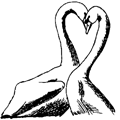Papers in the Biological Sciences

Handbook of Waterfowl Behavior by Paul A. Johnsgard
Date of this Version
January 1965
Document Type
Book Chapter
Abstract
The tribe includes the 16 species of sheldgeese and shelducks ("Lophonetta" and Tachyeres are here excluded from the tribe) which provide such a smooth transition from the true geese to the true ducks that it is difficult to establish a dividing line between the two groups. I believe that the line is best placed between Cereopsis on the anserine side and Cyanochen on the anatine side. Cyanochen is clearly a sheldgoose, but the plumages and voices of the sexes are practically alike, as are also their displays. Cyanochen and the other Tadornini are characterized by a downy plumage that is strongly marked with dark and white, by a tendency to nest in cavities, and by the fact that they forage either by grazing (sheldgeese) or by grazing and dabbling (shelducks). Metallic plumage coloration is encountered in this group, as are vermiculated feather patterns; both are typical of most of the rest of the Anatinae. Pair bonds appear to be fairly strong in sheldgeese, but less strong in shelducks. Unlike that of the true geese, pair-forming, or courtship, behavior is conspicuous, and in this group may be observed the basic pair-forming mechanism which is to be found, in varying degrees of refinement, in all other tribes of Anatinae. Simply stated, this is the tendency of the female to Incite (Lorenz, 1951-1953) males to attack other males or females, and to "select" her mate on the basis of the male's reaction to this Inciting. Here sexual selection enters the picture, and the complex male plumage patterns and male courtship- behavior patterns can be understood and interpreted only by reference to the principle of sexual selection.


Comments
From Handbook of Waterfowl Behavior by Paul A. Johnsgard. Copyright © 1965 Cornell University Press; electronic edition copyright © 2008 Paul A. Johnsgard.